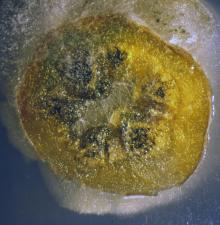Cause Verticillium dahliae, a soilborne fungus that infects a wide range of crops, vegetables, fruits, and ornamentals, and which survives in soil up to 14 years as microsclerotia produced in infected plants. It infects via roots, invading water-conducting tissue, and spreads systemically throughout the plant. Moist soil and temperatures between 70°F and 81°F favor the disease. No resistant or tolerant varieties are available. Young plants can be infected but symptoms may be delayed until flowering or fruit-set.
Symptoms Under stress from heat and/or fruit set, wilting and yellow, V-shape areas at the leaf edge develop; wilting or leaf symptoms may develop on only one side of the plant. Leaves turn completely yellow and dry up. Wilting progresses up the plant until the plant dies; plants not killed are stunted. A cross-section of a node near the plant base may reveal discolored vascular tissue.
Cultural control
- Grafting resistant cucurbit rootstock such as 'Tetsukabuto' squash is effective.
- Avoid planting in fields known to have a Verticillium wilt problem.
- Avoid moving soil or debris from infested fields.
- Avoid planting in former potato, tomato, or mint fields.
- Remove diseased plants and postharvest debris to reduce fungal buildup.
Chemical control Fumigating soil has been effective in the Hermiston, OR area.
- Metam sodium (Vapam HL) at various rates. See label for details. Restricted-use pesticide.
Biological control
- Bexfond at 7 to 28 fl oz/A for soil applications at planting via drenches, in-furrow applications, drip irrigation, or sprays, followed by irrigation, and reapply at 4- to 8-week intervals. 4-hr reentry. O


